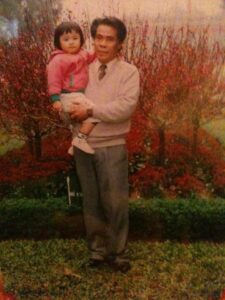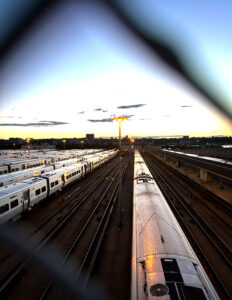Dear Little Buddies,
[mom at 22] One random night in New York, I somehow found myself at an intimate dinner with a fascinating mix of industry heavyweights – hedge fund titans who probably made more money in the last hour than I had in my entire career, tech founders whose apps I’d definitely doom-scrolled through, a real estate mogul who casually mentioned owning half of SoHo, and a filmmaker whose indie project had just been picked up by A24.
And there I was, sitting among them, feeling like the least accomplished, least famous, and least camera-ready person in the room. Relax – at that time, I was 21.75, not some tycoon. I had shown up as a researcher, tagging along to help my academic brother pitch his idea. My businesses existed, sure, but compared to the giants at that table, they felt like tiny sandcastles on the shore, waiting for the next wave to knock them down.
To be clear, this was absolutely not my comfort zone. I wasn’t used to rubbing shoulders with people who could casually drop phrases like “our latest billion-dollar valuation” or “the book I just sold to Netflix.” I spent the first half of the night feeling like a random extra in a movie I hadn’t auditioned for. But as the night went on, something unexpected happened.
As I listened to their stories, a common thread started to appear. These wildly successful, brilliantly creative people? None of them had followed some perfectly scripted path. There was no magical formula, no divine blueprint that had led them straight to the top. Instead, their journeys were filled with blind optimism, unexpected failures, and moments of sheer, reckless courage.
It turned out that success wasn’t just about talent or having the perfect plan. More often than not, it came down to persistence, a bit of luck, and the willingness to take a leap – even when they had no idea where they’d land. And that’s what I learned that night – discomfort is often the price of growth. Sometimes, the best thing you can do is throw yourself into rooms where you feel out of place because, eventually, those rooms start feeling like home.
[Now I’m 25. Continuing this topic after reading 7749 history books and trained my consultants]
We’re Wired to Play It Safe – But That’s Holding Us Back
We come into this world wrapped in instincts meant to protect us. And for the most part, they do. We grow up learning to hold hands when we cross the street, to look both ways, to stay where it feels familiar. It’s comforting. It feels right. But sometimes, the same instincts that once kept us safe begin to keep us small.
If there’s one thing humans have mastered over thousands of years, it’s avoiding danger at all costs. Sure, we like to think of ourselves as adventurous, bold, and full of big ideas – but the truth is, we are biologically programmed to play it safe. We’ve been taught – quietly, over generations – that the safest life is the best one. That steady is the goal. But steady can also mean still. And still, over time, can begin to feel like stuck.
Think about it. Our ancestors didn’t survive because they were daredevils; they survived because they didn’t take unnecessary risks. They weren’t out there experimenting with whether that mysterious berry was poisonous or casually strolling into dark caves just to “see what happens.” No, they stuck to what they knew, avoided unnecessary danger, and lived long enough to pass on their cautious little genes.
Fast-forward to today, and we still have that same wiring – except now, the “threats” we avoid aren’t life-or-death situations. They’re things like putting ourselves out there, trying something new, or risking failure. Instead of running from predators, we run from embarrassment. Instead of hunting for food, we hunt for validation. And instead of dodging real, physical danger, we dodge discomfort – the fear of rejection, of looking foolish, of failing in public.
But here’s the problem: sticking to what feels safe and familiar keeps us from ever doing anything great. The people we admire, the ones who build, create, and lead? They aren’t fearless – they just know that fear isn’t a good enough reason to not try. They’ve figured out that while our instincts scream stay comfortable, real progress only happens when we push past that initial fear.
So the next time our brain tells us to back down from something just because it feels scary, remind ourselves: we are not running from a saber-tooth tiger. We are just scared of stepping outside your comfort zone – and that’s exactly why we should do it.
Your Fear of Risk Is Outdated
For most of human history, stepping outside the norm wasn’t just frowned upon – it was downright dangerous. If you dared to challenge the status quo, you weren’t just met with raised eyebrows; you were met with a one-way ticket to disaster.
- Ancient Greece (399 BCE): Socrates questioned authority, asked too many inconvenient questions, and challenged people to think for themselves. His reward? A trial for “corrupting the youth” and a cup of poison hemlock.
- 15th-Century China: Admiral Zheng He led grand naval expeditions that connected China to Africa and the Middle East. But after his death, the emperor decided that exploration was too risky, burned his ships, and banned seafaring. Meanwhile, Europe embraced exploration—and history tells us which region dominated global trade afterward.
- 19th-Century France: Victor Hugo, one of the greatest writers of all time, was exiled from France for daring to criticize Napoleon III’s government. He wrote Les Misérables in exile, proving that being banished for speaking up isn’t always a bad thing.
- 1950s America: Women who pursued careers instead of marriage were labeled “spinsters” and shamed for being “too ambitious.” Today, those “ambitious” women built industries, ran companies, and pioneered science and politics.
For most of civilization, blending in wasn’t just a choice – it was survival. Questioning authority, challenging norms, or simply daring to be different could get you killed, exiled, or erased from history.
But today? Risk-taking isn’t just safer – it’s necessary.
Nobody’s going to execute you for starting a business, writing a controversial book, or launching a wild new idea. But your brain still acts like taking risks will get you kicked out of society. That outdated fear is keeping too many people stuck in jobs they hate, relationships that don’t fulfill them, and lives they never truly chose.
The Math of Risk Has Changed – And Maybe So Can We
Once upon a time, risk meant danger – real danger. To step out of line could mean losing your home, your status, your safety. For generations, survival depended on playing it safe. Staying quiet. Blending in. Living within the lines.
But the lines have shifted.
Today, risk doesn’t mean being chased by wild animals or banished from the village. More often, it means facing uncertainty – and maybe your own self-doubt. And yet, our hearts still race as if the consequences are irreversible. As if trying something new will undo us.
But will it?
You apply to a program you’ve dreamed of. Worst case? You don’t get in, and you feel crushed for a few days. Best case? You get in – and it changes the trajectory of your life.
You move to a new city, hoping to start fresh. Worst case? You feel lonely at first, and it takes time to adjust. Best case? You meet people who feel like home, and you discover a version of yourself you didn’t know existed.
You tell someone you love them. Worst case? They don’t feel the same, and your heart hurts for a while. Best case? They say it back – and a new chapter begins.
You share something you created – a story, a product, an idea. Worst case? People ignore it. Or judge it. Or misunderstand it. Best case? Someone out there sees it and says, “This is exactly what I needed.”
Even the heaviest setbacks – rejections, failures, losses – carry within them the seeds of something meaningful. A deeper knowing of who you are. A quiet strength you didn’t know you had. And often, a new beginning disguised as an ending.
The truth is, we’re living in a time where the downside of risk is often discomfort. But the upside? It’s limitless. Connection. Growth. Meaning. Purpose. Freedom.
It’s not that risk doesn’t hurt – it can. And yes, it might bruise your ego, stretch your finances, or test your resilience. But it also has the power to transform. Not just what you do, but how you see yourself.
The math has changed. The rules have changed.
Maybe now it’s not about survival anymore. Maybe it’s about aliveness.
And maybe the scariest thing isn’t failing – it’s never giving yourself the chance to fly.
We still carry the instincts of a time when playing it safe meant staying alive. But what if today, playing it safe just means staying small?
Maybe the greatest risk now isn’t falling – it’s not showing up for the life you were meant to live.
So what does it mean?
I won’t go into every single insane decision I’ve made that stressed my parents out…
But when I look back, every leap I took – every time I ignored the instinct to play it safe – led to something bigger. And the best part? The things I once thought were massive risks don’t even feel that scary anymore. That’s the magic of risk-taking – it expands your comfort zone until the things that once terrified you become second nature.
And here’s the kicker: Most of the risks we fear are just… social risks.
- Asking someone out? If they say no, you move on.
- Pitching your idea? The worst outcome is some awkward silence… and some nos.
- Speaking up? If people disagree, at least they noticed you.
Most of the time, the only thing stopping you is your own mind.
Live a Life Without Regret
One of the books that quietly stayed with me is The Top Five Regrets of the Dying by Bronnie Ware. She was a palliative care nurse, spending time with people in their final days. She didn’t ask them what they accomplished, how much they earned, or how many followers they had. She listened. And over time, one regret rose above all the rest.
“I wish I had lived a life true to myself, not the one others expected of me.”
Not, “I wish I had been more careful.”
Not, “I wish I had made fewer mistakes.”
But: “I wish I had dared more. Chosen differently. Trusted myself sooner.”
That hits deep.
Because fear doesn’t always scream – it whispers. It tells us there’s still time. That we can wait until we feel ready. That it’s better to not rock the boat, not disappoint anyone, not risk looking foolish.
But the truth? Time isn’t promised. And the things we put off – the dream, the confession, the leap – don’t always wait for us.
One day, you might look back and wonder:
What if I had just gone for it?
What if I had chosen my own voice over someone else’s approval?
What if I had taken that chance, even trembling?
We spend so much energy trying not to fall. But maybe the real loss is never learning how high we might’ve flown.
So here’s my challenge to you: Don’t let fear win.
Take the risk.
Start the thing.
Speak up.
Make the move.
Because at the end of the day, the real risk isn’t failure. It’s never knowing what could have been.



